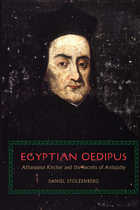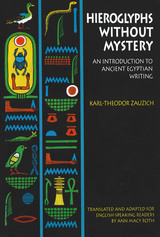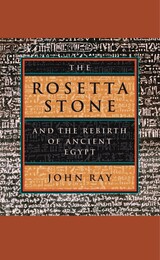

Marveling over the tomb treasures of Ramses II and Tutankhamen that have toured U.S. and European museums in recent years, visitors inevitably wonder what the mysterious hieroglyphs that cover their surfaces mean. Indeed, everyone who is fascinated by ancient Egypt sooner or later wishes for a Rosetta stone to unlock the secrets of hieroglyphic writing.
Hieroglyphs without Mystery provides the needed key. Written for ordinary people with no special language skills, the book quickly demonstrates that hieroglyphic writing can be read, once a few simple principles are understood. Zauzich explains the basic rules of the writing system and the grammar and then applies them to thirteen actual inscriptions taken from objects in European and Egyptian museums. By following his explanations and learning the most commonly used glyphs, readers can begin to decode hieroglyphs themselves and increase their enjoyment of both museum objects and ancient Egyptian sites.
Even for the armchair traveler, learning about hieroglyphs opens a sealed door into ancient Egyptian culture. In examining these inscriptions, readers will gain a better understanding of Egyptian art, politics, and religion, as well as language.
This book was originally published in Germany in 1980 as Hieroglyphen ohne Geheimnis.

The Rosetta Stone is one of the world’s great wonders, attracting awed pilgrims by the tens of thousands each year. This book tells the Stone’s story, from its discovery by Napoleon’s expedition to Egypt to its current—and controversial—status as the single most visited object on display in the British Museum.
A pharaoh’s forgotten decree, cut in granite in three scripts—Egyptian hieroglyphs, Egyptian demotic, and ancient Greek—the Rosetta Stone promised to unlock the door to the language of ancient Egypt and its 3,000 years of civilization, if only it could be deciphered. Capturing the drama of the race to decode this key to the ancient past, John Ray traces the paths pursued by the British polymath Thomas Young and Jean-François Champollion, the “father of Egyptology” ultimately credited with deciphering Egyptian hieroglyphs. He shows how Champollion “broke the code” and explains more generally how such deciphering is done, as well as its critical role in the history of Egyptology. Concluding with a chapter on the political and cultural controversy surrounding the Stone, the book also includes an appendix with a full translation of the Stone’s text.
Rich in anecdote and curious lore, The Rosetta Stone and the Rebirth of Ancient Egypt is a brilliant and frequently amusing guide to one of history’s great mysteries and marvels.
READERS
Browse our collection.
PUBLISHERS
See BiblioVault's publisher services.
STUDENT SERVICES
Files for college accessibility offices.
UChicago Accessibility Resources
home | accessibility | search | about | contact us
BiblioVault ® 2001 - 2024
The University of Chicago Press









